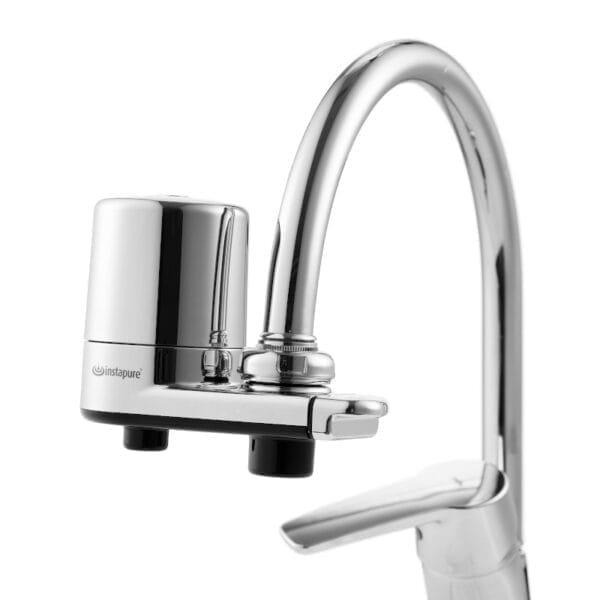Why it is important to have a water filter at home!
Authored by: Kevin Skillström
We often take for granted that our tap water is perfectly clean and healthy, but the truth is that it may contain more unwanted substances than we think. Even if Swedish drinking water is of a high standard, it can still contain residues of heavy metals, microplastics, pharmaceutical residues, chlorine and other contaminants that affect both taste and health. A water filter on your tap is therefore not just a luxury, it’s an investment in your and your family’s well-being. With a good filter, you get cleaner, healthier and more natural water, just as nature intended.
What could actually be in our tap water?

Although Swedish water is considered to be among the cleanest in the world, several studies show that small amounts of contaminants often remain. These levels are usually low, but prolonged exposure can still affect the body. Here are some of the most common and worrying substances:
1. heavy metals – lead, copper, zinc and cadmium
Heavy metals can creep into the water from old pipes and wiring, especially in older houses. One of the biggest problems is lead, which can affect the brain and nervous system, especially in children. It can eventually affect concentration and learning. Copper is naturally present in small amounts and the body actually needs some of it, but if levels get too high it can irritate the stomach and put strain on the liver. Cadmium and zinc can also leach out of some pipes, and if you ingest too much over a long period of time, it can affect your kidneys and bones. With a good water filter, you don’t have to worry about this. The filter traps heavy metals before they reach your glass, helping both children and adults avoid unnecessary strain on their bodies.
2. microplastics and chemicals from households and industry
Microplastics have become a growing problem worldwide, and Sweden is unfortunately no exception. These tiny plastic particles come from synthetic clothing, cleaning products and plastic packaging that have broken down over time. They are so small that they easily pass through wastewater treatment plants and end up in our drinking water. The plastic itself is not the problem, but the problem is that microplastics often bind to other substances, such as chemicals, pesticides and PFAS, that the body would rather not have. Scientists believe that these substances can disrupt the body’s hormones, affect fertility and, in the long term, contribute to various hormone-related problems. A good water filter, especially one with activated carbon or reverse osmosis, can reduce the amount of microplastics and other unwanted chemicals in your water. This means cleaner, fresher and safer water every time you turn on the tap.
3. PFAS – the perpetual chemicals
PFASs are a group of chemicals that have been used in everything from frying pans and dirt-repellent clothing to fire-fighting foam. They are extremely persistent and are therefore often referred to as perpetual chemicals. Unfortunately, PFAS have been found in drinking water in several places in Sweden, especially in areas near industries or fire training sites. The problem with PFAS is that they build up in the body over time and can disrupt the hormone system, affect the immune system and in some cases are linked to liver damage and reduced fertility. Although the levels are usually small, the long-term effects can be significant, especially if they are ingested daily over many years. An activated carbon or reverse osmosis water filter is one of the most effective ways to remove PFAS from drinking water, which can be particularly important for families with children or pregnant women.
4. Pharmaceutical residues and endocrine disruptors
Every day, small amounts of medicines and chemicals are flushed out of our homes, and wastewater treatment plants are not always built to catch them all. This is why researchers have found traces of antibiotics, painkillers and hormones in both lakes and drinking water. These are very small amounts, but even low levels can affect the body in the long term, for example by disrupting gut flora, hormones or the body’s own ability to cleanse itself. Children and pregnant women may be particularly sensitive to certain substances. With an activated carbon filter, you reduce the amount of pharmaceutical residues and endocrine disruptors in your water. The result is a more natural and balanced water that your body feels better with.
5. Chlorine and disinfection by-products
To keep water bacteria-free, many municipalities add chlorine. This is necessary to avoid dangerous bacteria, but it can also leave a bad taste and dry out skin and hair. In addition, chlorine can react with natural substances in the water to form by-products that are unhealthy for the body in the long run. Many people recognize that their tap water sometimes smells a bit like a swimming pool, and it’s the chlorine that you smell. An activated carbon filter effectively removes chlorine and its by-products, making the water taste fresher and feel gentler on the body.
How does a water filter purify our tap water at home?
It’s easy to think that tap water in Sweden is always clean, but in reality it can contain small amounts of substances that we would rather not ingest. That’s why more and more people are choosing to install a water filter at home, a simple way to take control of water quality while protecting both their health and the environment. One of the most popular and effective options is carbon filters, which are often made from natural carbon from coconuts. It works through a process called adsorption, not absorption like a sponge, but adsorption where the substances stick to the surface, a bit like Velcro. As the water passes through the filter, the contaminants are drawn to the surface of the carbon and remain there, while the clean water continues out through the tap. Carbon filters are extremely porous, which means they have a huge surface area where particles can get trapped. The slower the water flows, the more the filter can trap, so they work best at a steady and calm flow. They effectively remove up to 99% of lead, chlorine, microorganisms, PFAS, pharmaceutical residues and pesticides, while greatly improving the taste and smell of the water. The Aroniabutiken uses a carbon filter based on coconut shells, which is both proven and environmentally friendly. It is easy to install directly on the tap without tools, and you can switch between filtered and unfiltered water with a simple switch. One filter cartridge lasts about three months for a family of four, and when it runs out, it can be replaced quickly and cheaply. In addition to providing clean water straight from the tap, filters also contribute to a more sustainable way of life. Instead of buying bottled water (which often contains microplastics and requires a lot of plastic production), you can drink good, clean water at home, without burdening the planet.
Different types of water filters
When it comes to clean water straight from the tap, there are several different types of water filters, and the choice depends on what you want to filter out and how you want to use the water. Here are the most common options:
1. Carbon filters Carbon filters are perhaps the most popular and effective for households. They remove chlorine, bad tastes and odors, as well as many organic substances and some heavy metals. At the same time, carbon filters preserve the minerals that the body needs, making the water both fresh and healthy. They are available as filter jugs, filter cassettes on the tap or as fixed filters under the sink.
2. Reverse osmosis (RO) Reverse osmosis is a more advanced filtration that removes almost all contaminants, including heavy metals, nitrates, microplastics and bacteria. The water is pressed through a semi-permeable membrane that acts as a super-fine sieve. The result is extremely pure water, but as some minerals are also removed, it can be helpful to supplement with mineral-enriched water for balance.
3. ceramic filters Ceramic filters use a very fine mesh material that effectively traps bacteria, sand and sediment. They are often combined with carbon filters to also improve taste and remove chlorine. Ceramic filters are durable, long-lasting and can sometimes be cleaned and reused, making them an environmentally friendly option.
4. UV filters UV filters use ultraviolet light to kill bacteria and viruses in the water. They do not remove chemicals or heavy metals, but are a great addition when you want to make sure your water is microbiologically clean. UV filters are often used in conjunction with carbon filters to provide both purity and great taste.
5. combination filters Many modern water filters combine several technologies, such as carbon filters and ceramic filters, or carbon filters and UV light. The combination allows the filter to remove both taste and odor problems, heavy metals, bacteria and sediment, all at once.
Choosing a water filter comes down to needs, taste preferences and how much filtration you want. For everyday use, a carbon filter is often enough, while families who want maximum safety and purity can opt for reverse osmosis or a combination filter. With the right filter, you don’t just get clean water, you get peace of mind, better taste and an easier way to protect your health every day.
What have we learned?
Swedish tap water is generally of high quality, but it can still contain small amounts of substances that we would rather not ingest, such as heavy metals, microplastics, PFAS, pharmaceutical residues and chlorine. These substances can come from old water pipes, industries, households and wastewater treatment plants that do not always capture everything. Although levels are usually low, long-term exposure can have negative effects on the body and health, especially in children and pregnant women.
A tap water filter is therefore a simple and effective way to improve water quality at home. Activated carbon or reverse osmosis filters remove up to 99% of contaminants and provide cleaner, healthier and more natural water. At the same time, it improves taste and smell, and avoids unnecessary chemicals that can disrupt hormones, affect organs or dry out the skin. There are several types of filters, such as carbon filters, ceramic filters, UV filters and reverse osmosis, and the most suitable one depends on the substances you want to filter out.
Whichever you choose, a water filter is not only good for your health, but also an environmentally friendly alternative to bottled water. With a filter, you get clean, fresh water straight from the tap every day.
Buy your water filter at Aroniabutiken – Water purification

